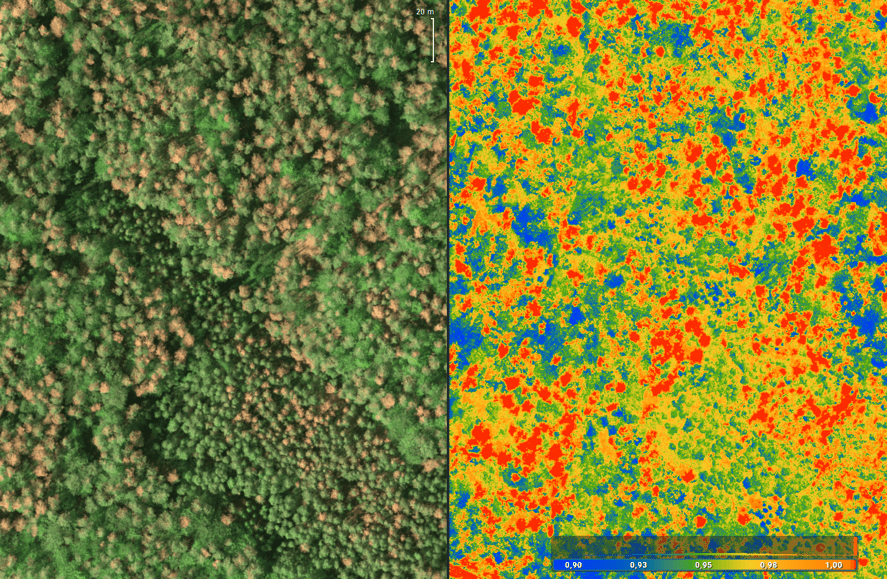Severe hailstorms produce large-size hailstones (2cm diameter and more) that can cause devastating damage to crops, property, and forests. The resulting damage from hailstorms depends on many factors including hailstone size, the number of stones per unit area, wind speed, storm duration, and general weather conditions before and after the storm. Vegetation is also more susceptible to damage at different times of the year. In spring, plants are sprouting and growing new leaves and stems, making them more prone to suffer severe damage from hail.
In forests and on trees specifically, hail damage manifests in defoliation and split and broken stems. The tips and tops of trees can also become scarred and pitted by the hail, which makes trees extremely susceptible to pathogenic fungus and bacterial diseases. Partial defoliation also affects the wood properties, which can result in a decrease in yield.
Damage Assessment
Measuring hailstorm damage in forests has historically been challenging and infrequent. Whereas farmers rely on field surveys to quantify crop damage, foresters rarely monitor after hail storms due to large forest size and inaccessibility of terrain.
Forest monitoring has often been done using satellite or manned-aircraft-based data, however recently drone-based imagery has become more popular due to ease of use and high-resolution sensors that give foresters access to a level of detail they did not have before.
In the midst of increased frequency of abiotic phenomena threatening the sustainability of forest ecosystems, and with 30% of Poland’s territory covered by forests, local foresters are increasingly turning to modern and efficient tools that facilitate the acquisition of high-resolution images.
Most forests in Poland are located in the northern and western parts of the country as well as the Carpathian Mountains in the extreme south, where the Oleszyce Forest is located. Hailstorms in Poland are more frequent in the northern region, but rare in the Podkarpackie Province, averaging only 2 to 3 days a year. However, the infrequency of hailstorms doesn’t have a direct relationship with the severity. On June 16th, 2019 the Oleszyce Forest suffered an especially severe hailstorm that put its forest ecosystem at risk.
The Mission
Navigate, a GIS equipment reseller and service provider was hired in August 2019 to map 22,4 ha of the Oleszyce Forest and assess the damage.
Planned in Pix4DCapture, the mission was flown with a DJI Matrice 600 Pro equipped with the MicaSense series RedEdge-M. The data captured was subsequently processed in Pix4DFields and showed clear signs of damage in tree-tops, needles, fine and thick branches, and fragments of the upper parts of tree trunks. Wounds suffered from hailstones turned out to be deep enough to cause disturbances in the conductive cell layer and thus limiting the transport of water, resulting in moisture deficit, loss of turgor, and gradual needle withering.
As a symptom of this process, the leaf pigmentation changed from light green to dark red. The first signs were noted as early as 10 days after the hailstorm. However, the damage was shown to be progressive as more intense red leaf coloration was detected 40 days after the hailstorm. About 20% of common pine trees and slightly more than 1% of deciduous undergrowth were damaged.





The Results
Pix4Dmapper helped the team perform a comprehensive analysis of the data. Guided by the resulting classification map, the team highlighted areas with stressed and damaged trees. These tools helped ensure the precise planning of the size of the sanitary cuts and the volume of harvested wood As a result, only 13% of the pine stand in this area was cut and the rest was covered by protective treatments.
Conclusion
Foresters are increasingly using new methods for capturing and analyzing high-resolution images to monitor phenomena like hailstorms. the effects of which may significantly impact forest ecosystem function. This example shows how multispectral imagery combined with analytic tools and professional knowledge can help guide and inform strategic business decisions.





